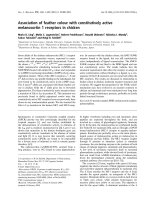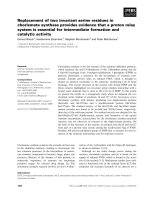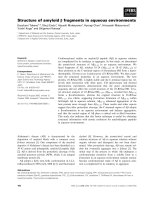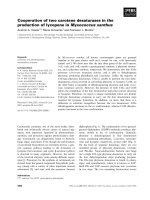Báo cáo " Local polynomial convexity of union of two graphs with CR isolated singularities" doc
Bạn đang xem bản rút gọn của tài liệu. Xem và tải ngay bản đầy đủ của tài liệu tại đây (139.97 KB, 5 trang )
VNU Journal of Science, Mathematics - Physics 24 (2008) 6-10
Local polynomial convexity of union of two graphs with CR
isolated singularities
Kieu Phuong Chi
∗
Department of Mathematics, Vinh University, Nghe An, Vietnam
Received 26 October 2007; received in revised form 4 December 2007
Abstract. We give sufficient conditions so that the union of two graphs with CR isolated
singularities in C
2
is locally polynomially convex at a singularly point. Using this result and
some ideas in previous work, we obtain a new result about local approximation continuous
function.
1. Introduction
We recall that for a given compact K in C
n
, by
ˆ
K we denote the polynomial convex hull of
K i.e.,
ˆ
K = {z ∈ C
n
: |p(z)| ≤ p
K
for every polynomial p in C
n
}.
We say that K is polynomially convex if
ˆ
K = K. A compact K is called locally polynomially convex
at a ∈ K if there exists the closed ball B(a) centered at a such that B(a) ∩K is polynomially convex.
A smooth real manifold S ⊂ C
n
is said to be totally real at a ∈ S if the tangent plane T
S
(a) of
S at a contains no complex line. A point a ∈ S is not totally real that will be called a CR singularity.
By the result of Wermer, if K is contained in totally real smooth submanifolds of C
2
then K is locally
polynomially convex at all point a ∈ K (see [1], chapter 17). Note that union of two polynomially
convex sets which can be not polynomially convex set. Let D be a small closed disk in the complex
plane, centered at the origin and
M
1
= {(z,
z) : z ∈ D}; M
2
= {(z, z + ϕ(z)) : z ∈ D},
where ϕ is a C
1
function in neighborhood of 0, ϕ(z) = o(|z| ). Then M
1
, M
2
are totally real(locally
contained in a totally real manifold), so that M
1
, M
2
are locally polynomially convex at 0. The local
polynomially convex hull of M
1
∪ M
2
is essentially studied by Nguyen Quang Dieu (see [2,3]).
Let
X
1
= {(z,
z
n
) : z ∈ D}, X
2
= {(z, z
n
+ ϕ(z)) : z ∈ D}, ∗
where n ≥ 1 is interger and ϕ is a C
1
function in neighborhood of 0, ϕ(z) = o(|z|
n
). If n > 1 then
X
1
and X
2
is not totally real at 0, so we can not deduce that X
1
and X
2
are locally polynomially at 0
by the Wermer’s work. However, using the results about local approximation of De Paepe (see [4]) or
the work of Bharali (see [5]), we can conclude that X
1
and X
2
are locally polynomially convex at 0.
In this paper, we will investigate the local polynomially hull of X
1
∪ X
2
at 0. The ideas of proof takes
∗
E-mail:
6
Kieu Phuong Chi / VNU Journal of Science, Mathematics - Physics 24 (2008) 6-10 7
from [2] and [3]. An appropriate tool in this context is Kallin’s lemma (see [6,7]): Suppose X
1
and
X
2
are polynomially convex subsets of C
n
, suppose there is polynomial p mapping X
1
and X
2
into two polynomially convex subsets Y
1
and Y
2
of the complex plane such that 0 is a boundary
point of both Y
1
and Y
2
and with Y
1
∩ Y
2
= {0}. If p
−1
(0) ∩ (X
1
∪ X
2
) is polynomially convex,
then X
1
∪ X
2
is polynomially convex. Several instances of such a situation, motivated by questions
of local approximation, were studied by O’Farell, De Paepe and Nguyen Quang Dieu (see [8-10], ).
Let f be a continuous function on D. We denote that [z
2
, f
2
; D] is the function algebra which
consisting of uniform limit on D of all polynomials in z
2
and f
2
. Using polynomial convexity theory,
it can be shown that [z
2
, f
2
; D] = C(D) for some choices a C
1
function f, which behaves like
z near
the origin (see [9-11] ). By the known result about approximation of O’Farrell, Preskenis and Walsh
[12] :if X is polynomially convex subset of the real manifold M, K is a compact subset of X
such that X \ K is totally real. Then, if f is continuous function on X and f can be uniform
approximated by polynomials on K then f can be uniform approximated by polynomials on X,
and the techniques developed in [13], we give a class function f which behaves like
z
n
such that
[z
2
, f
2
; D] = C(D).
2. The main results
We always take the graphs X
1
and X
2
of the form (∗). For each r > 0 we put
X
r
i
= X
i
∩ {(z, w) : |z| ≤ r}, i = 1, 2.
Now we come to the main results of this paper.
Theorem 2.1. Let m, n be posi tive integers with m > n. Let ϕ be a C
1
function which is defined
near 0 of the form
ϕ(z) =
+∞
k=−∞
a
k
z
k
z
m−k
+ f(z) z = 0
0 z = 0,
where f(z) is a C
1
function and f(z) = o(|z|
m
). S uppose that there exists l ≤
m
2
such that
|a
l
| >
k=l
|a
k
| (1)
and
m−2l
n
is integer. Then X
1
∪ X
2
is locally polynomially convex at 0.
Proof. Consider the polynomial p(z, w) =
αz
m−2l+n
+αw
m−2l
n
+1
with α choose later. Thus p(X
1
) =
αz
m−2l+n
+ αz
m−2l+n
belongs to real axis and
p(X
2
) =
αz
m−2l+n
+ α(z
n
+
+∞
k=−∞
a
k
z
k
z
m−k
+ f(z))
m−2l
n
+1
=
=
αz
m−2l+n
+ αz
m−2l+n
+ α(
m − 2l
n
+ 1)
z
m−2l
+∞
k=−∞
a
k
z
k
z
m−k
+ o(|z|
m
).
From p(X
1
) = αz
m−2l+n
+ αz
m−2l+n
∈ R , we obtain
Im p(X
2
) = Im(α(
m − 2l
n
+ 1)
z
m−2l
+∞
k=−∞
a
k
z
k
z
m−k
+ o(|z|
m
)).
8 Kieu Phuong Chi / VNU Journal of Science, Mathemat ics - Physics 24 (2008) 6-10
Choose α = i
a
l
|a
l
|
. It follows that
Imp(X
2
) ≥ |z|
2m−2l
(
m − 2l
n
+ 1)(|a
l
| −
k=l
|a
k
|) > 0 (2)
for any z = 0 in a small neighborhood of 0, by (1). It implies that p(X
2
) ∩ R = {0}. On the other
hand, from the inquality (2) we see that
p
−1
(0) ∩ X
r
2
= {0}.
It is elmentary to check that
p
−1
(0) ∩ X
r
1
= {(ρ exp(iθ), ρ
n
exp(−niθ)) : 0 ≤ ρ ≤ r},
with a constant θ. Obviously,
p
−1
(0) ∩ X
r
1
is polynomially convex for r small enough. Thus p
−1
(0)∩(X
r
1
∪X
r
2
) is polynomially convex for r small
enough. By Kallin’s lemma (mentioned in introduction) we conclude that X
r
1
∪ X
r
2
is polynomially
convex for r small enough. The proof is completed.
Remark. 1) In the Theorem 1 we can replace X
1
by
X
′
1
= {(z,
z
n
− ϕ(z)) : z ∈ D}.
Then, as p in Theorem 1 we obtain the estimate
Imp(X
′
1
) < 0,
for any z = 0 in small neighborhood of 0. On the other hand p
−1
(0) ∩ (X
′
r
1
∪ X
r
2
) = {0} for r small
enough. By Kallin’s lemma we may conclude that X
′
1
∪ X
2
is locally polynomially convex.
2) This result includes the more restricted case n = 1 that is studied by Nguyen Quang Dieu
(see [2]).
The following Proposition shows that if we replace l >
m
2
we may get nontrivial hull of X
r
1
∪X
r
2
.
Proposition 2.2. Let n, p be po sitive integers and
X
1
= {(z,
z
n
) : z ∈ D}; X
2
= {(z, z
n
+ z
p
z
n+p
) : z ∈ D}.
Then X
1
∪ X
2
is not locall y polynomially convex at 0.
Proof. For each t > 0, let W
t
= {(z, w) : z
n
w = t}. Consider the sets
P
t
:= W
t
∩ X
1
= {(z,
z
n
) : |z| = t
1
2n
};
Q
t
:= W
t
∩ X
2
= {(z,
z
n
+ z
p
z
n+p
) : |z| = s},
where s is unique positive solution of the equation s
2n
+ s
2p+2n
= t. By the maximum modulus
principle we see that the hull of X
r
1
∪ X
r
2
will contain an open subset of W
t
bounded by two closed
curves P
t
and Q
t
for any t > 0 small enough and hence X
1
∪ X
2
is not locally polynomially convex
at 0 .
Kieu Phuong Chi / VNU Journal of Science, Mathematics - Physics 24 (2008) 6-10 9
Theorem 2.3. Let m be a positive even integer and let n be a odd integer such th at m > n. Let g
be a C
1
function which is defi ned near 0 of the form
g(z) =
z
n
+
+∞
k=−∞
a
k
z
k
z
m−k
+ f(z)) z = 0
0 z = 0,
where f is a C
1
function and f(z) = o(|z|
m
). Suppose that there exists l such that
m−2l
n
is positive
integer and
|a
l
| >
k=l
|a
k
|. (3)
Then th e functions z
2
and g
2
(z) separate points near 0. Morever, [z
2
, g
2
; D] = C(D) for D small
enough.
We need the next lemma (see [7,8]) for the proof of Theorem 2.1.
Lemma 2.4. Let X be a compact subset of C
2
, and let π : C
2
→ C
2
be defined by π(z, w) =
(z
m
, w
n
). Let π
−1
(X) = X
11
∪ ∪ X
kl
∪ ∪ X
mn
with X
mn
compact, and X
kl
= {(ρ
k
z, τ
l
w) :
(z, w) ∈ X
mn
} for 1 ≤ k ≤ m, 1 ≤ l ≤ n, where ρ = exp
2πi
m
and τ = exp
2πi
n
. If
P (π
−1
(X)) = C(π
−1
(X)), then P (X) = C(X).
Proof of Theorem 2.3. First we show that the functions z
2
and g
2
(z) separate points near 0. Clearly
points a and b with a = −b are separated by z
2
. Now assume that g
2
(z) takes the same value at a
and −a for some a = 0. Set
h(z) =
+∞
k=−∞
a
k
z
k
z
m−k
+ f(z) z = 0
0 z = 0,
it follows that h(a) = −h(−a). As m is even, we have
+∞
k=−∞
a
k
a
k
a
m−k
=
−f(a) − f(−a)
2
.
Dividing both sides by a
m−l
a
l
we obtain
a
l
+
k=l
a
k
a
l−k
a
l−k
=
−f(a) − f(−a)
2a
m−l
a
l
.
By the inequality (3) and the fact that f (z) = o(|z|
m
), we arrive at a contradition if we choose the
disk D sufficiently small.
Next we consider for a small closed disk D the set
˜
X which is the inverse of the compact
X = {(z
2
, g
2
(z) : z ∈ D} under the map (z, w) → (z
2
, w
2
). We have
˜
X = X
1
∪X
2
∪X
3
∪X
4
where
X
1
= {(z,
z
n
+ h(z)) : z ∈ D};
X
2
= {(−z, −
z
n
− h(z)) : z ∈ D} = {(z, z
n
− h(−z)) : z ∈ D};
X
3
= {(−z,
z
n
+ h(z))) : z ∈ D};
X
4
= {(z, −z
n
− h(z)) : z ∈ D} = {(−z, z
n
− h(−z)) : z ∈ D};
10 Kieu Phuong Chi / VNU Journal of Science, Mathemat ics - Physics 24 (2008) 6-10
By Remark 1), X
1
∪ X
2
is polynomially convex for D small enough . We have X
3
∪ X
4
is the image
of X
1
∪ X
2
under the biholomorphic map (z, w) → (−z, w). So X
3
∪ X
4
is also polynomially convex
with D sufficiently small.
Now we consider the polynomial q(z, w) = z
n
w. Then q maps X
1
∪ X
2
to an angular sector
situated near the positive real axis, while p maps X
3
∪X
4
to such sector situated near the negative real
axis. The sectors only meet at the origin. Applying Kallin’s lemma we get
˜
X = X
1
∪ X
2
∪ X
3
∪ X
4
is polynomially convex with D small enough. Furthermore, notice that
˜
X \ {0} is totally real (locally
contained in a totally real manifold), by an approximation theorem of O’Farrell, Preskenis and Walsh
(mentioned in introduction), we get that every continuous function on
˜
X can be uniformly approximated
by polynomials. By the Lemma 2.4, we see that the same is true for X, which is equivalent to the
fact that our algebra equals C(D).
Acknowledgements. The author is greatly indebted to Dr. Nguyen Quang Dieu for suggesting the
problem and for many stimulating conversations.
References
[1] H. Alexander, J. Wermer, Several Complex Variables and Ba nach Alg ebras, Grad. Texts in Math., Springer-Verlag, New
York, 35 (1998).
[2] Nguyen Quang Dieu, Local polynomial convexity of tangentials union of totally real graphs in C
2
, Indag. Math., 10
(1999) 349.
[3] Nguyen Quang Dieu, Local hulls of union of totally real graphs lying in real hypersurfaces, Michigan Math. Journal.,
47 (2) (2000) 335.
[4] P.J. de Paepe, Approximation on a disk I, Math. Zeit., 212 (1993) 145.
[5] G. Bharali, Surfaces with degenerate CR sigularities that are locally polynomially convex, Michigan Math. Journal., 53
(2005) 429.
[6] E. Kallin, Fat polynomially convex sets, Function Algebras, (Proc. Inter. Symp. on Function Algebras, Tulane Univ,
1965), Scott Foresman, Chicago, (1966) 149.
[7] P.J. de Paepe, Eva Kallin’s lemma on polynomial convexity, Bull. of L ondon Math. Soc., 33 (2001) 1.
[8] Kieu Phuong Chi, Function algebras on a disk, VNU Journal of Sciences, Mathematics - P hysics No3 (2002) 1.
[9] Nguyen Quang Dieu, P.J. de Paepe, Function algebras on disks, Complex Variables 47 (2002) 447.
[10] Nguyen Quang Dieu, Kieu Phuong Chi, Function algebras on disks II, Indag. Math., 17 (2006) 557.
[11] P.J. de Paepe, Algebras of continuous functions on disks, Proc. of the R. Irish. Acad., 96A (1996) 85.
[12] A.G. O’Farrell, K.J. Preskenis, Uniform approximation by polynoimials in two functions, Math Ann., 284 (1989) 529.
[13] A.G. O’Farrell, P.J. de Paepe, Approximation on a disk II, Math. Zeit., 212 (1993) 153.
[14] Kieu Phuong Chi, Polynomial approxiamtion on polydisks, VNU Journal of Sciences, Mathematics - Physics No3 (2005)
11.
[15] A.G. O’Farrell, K.J. Preskenis, D. Walsh, Holomorphic approximation in Lipschitz norms, Contemp. Math., 32 (1984)
187.
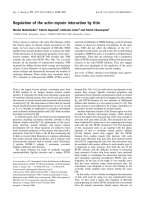
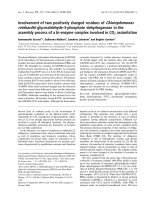
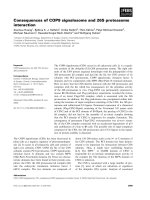
![Tài liệu Báo cáo khoa học: Expression of two [Fe]-hydrogenases in Chlamydomonas reinhardtii under anaerobic conditions doc](https://media.store123doc.com/images/document/14/br/hw/medium_hwm1392870031.jpg)
